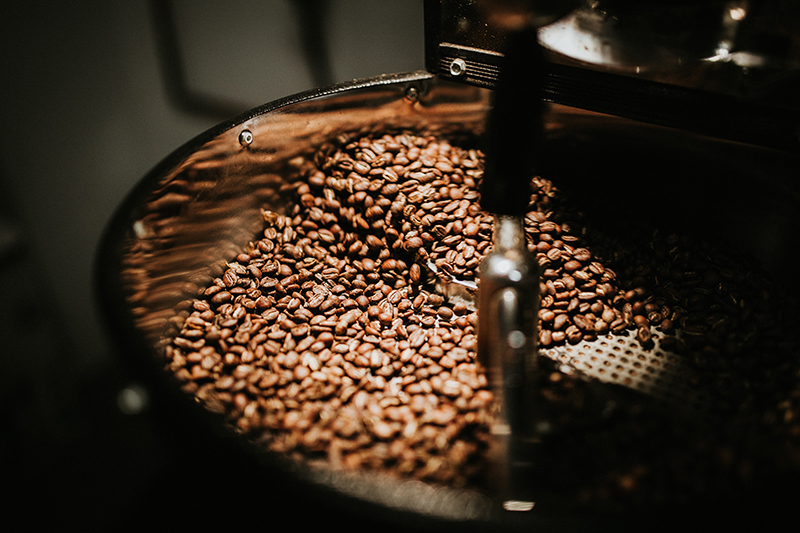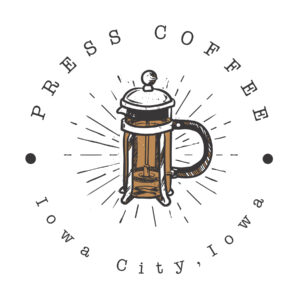Coffee: From Green Bean to Room for Cream
- Lisa Edwards
- Nov, 13, 2019
- Behind the Bar, Friends of Press
- Comments Off on Coffee: From Green Bean to Room for Cream
If you’ve been following along at home, your morning brew has a long journey before it makes its way to your cup. Thus far we have talked about how coffee is grown and processed, as well as demystifying all the words that come on your bag of coffee these days. When we left off, the coffee beans had been grown, picked, processed, and exported from their place of origin. Before the beans are ground up and brewed, they have to be roasted to unlock the hidden flavors and aromas that wake you up each morning.
At Press Coffee we handle brewing the coffee for you while the roasting gets done for us in three different locations: Capanna Coffee Roasters in North Liberty, Cafe del Sol Roasting in Iowa City, and Kickapoo Coffee Roasters in Viroqua, Wisconsin. Roasting coffee is a magical process where they take the freshly shipped green coffee beans, add variable amounts of heat and time, and ta-da– roasted coffee! Ok, it’s a little more complicated than that, but a bit of scientific sorcery does happen inside the coffee bean while it’s roasting.
The most common way to roast beans is in a horizontal drum that continually spins them while they are being heated, such as Kickapoo’s Probat roaster or Capanna’s San Franciscan brand roaster. Cafe del Sol utilizes a Sivetz roaster which relies on a fluid bed of hot air that roasts the beans while they tumble and levitate in a verticle chamber. The Sivetz roaster is fairly automatic, with a person monitoring the temperature of the bean. The drum roaster is a little more hands-on, requiring the operator to continually check the bean color and aroma, tweaking the heat and airflow according to roast profiles. Both come with some trial and error to bring out the best attributes in each batch of beans.
The variables for what kind of roast will suit which kind of bean starts on the farm with the altitude it was grown at, whether it was wet or dry processed, how much sun the crop gets, and more. Like most produce, the flavor ranges from region to region as well as when it is ready for harvest. Lightly roasted beans tend to highlight floral notes, acidity, and brightness while a darker roast focuses on the natural sweetness and caramel aromas of a bean.
The process begins by putting green, “raw” beans into the roaster where the heat first evaporates any remaining moisture, resulting in a loss of about 15-18% of its weight. As the water vaporizes and expands, a chemical process called pyrolysis occurs and the bean grows in size as it releases carbon dioxide and causes an audible cracking sound. The beans continue to heat allowing the aromatic and flavor compounds to develop, depending on what kind of roast is trying to be achieved. Once the beans are done roasting they must be released from the machine and rapidly cooled since they became exothermic during the process and would continue to roast otherwise.

Often labeled as light city, half city, or cinnamon, the lightest roast is ended after the first crack before the oils can be released from the bean. Most popular in the United States are medium roasts, classified as breakfast blend or American roast, and tend to release nutty and chocolatey flavors with muted acidity. Taking it a step further is the medium-dark bittersweet roast often classified as full-city. Roasting beans even longer will take it past a second crack of the bean, releasing the oils and producing a rich dark roast, lacking acidity but can leave a bitter aftertaste. This roast can be labeled as European, Viennese, Italian, French, or espresso.
Now that the beans are roasted and begin releasing carbon dioxide, they are susceptible to staling from heat, moisture, and specifically oxygen. Grinding the beans will quicken the pace of staling which is why best practice is to grind coffee just before brewing. Analyzing the profile of a bean after roasting is done is what’s called coffee cupping, similar to wine tasting, and helps describe the coffee from a wide range of attributes laid out on the Coffee Tasters Flavor Wheel.
Spend some time with your cup of coffee next time and try to decipher its body, aroma, and flavor to see what you can recognize in your favorite roast. Expand your coffee pallet by trying something new from a range of different coffee roasters. We believe the differences can be best identified through the brewing method of French press and would love to press you a cup of any of our coffees.

Pressing Newsletter
Social
Find us online:
Facebook
Instagram:
@PressCoffee_ic
@PupsofPress
TikTok
Yelp
Order through the Joe Coffee app!

